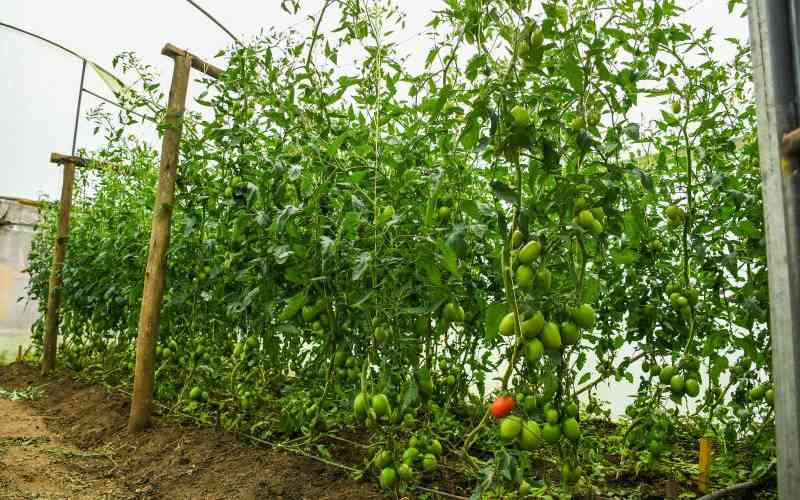Climate-smart project changing fortunes in Namanga

Over the past decade, the frequency and severity of climate extremes such as floods, landslides, and droughts have become increasingly apparent as the global climate continues to warm.
According to the 'State of the Climate Kenya report, the country experienced higher-than-normal temperatures in most regions in 2023, continuing a long-term trend of warming.
To mitigate these changes, climate experts are pushing for the adoption of advanced agriculture to ensure food sustainability for both humans and livestock.
Among the experts is Kinjanjui Mwangi, who is undertaking a significant farming project to cultivate Juncao Napier grass in Namanga, an area characterised by semi-dry land.
Climate-smart agriculture supports the cultivation of drought-resistant crops, which thrive in the warm climate due to effective climate change adaptation techniques.
"Climate-smart agriculture involves growing drought-resistant crops that can mature within very short periods," says Prof Mwangi.
A vast portion of Mwangi’s farm is occupied by Juncao Napier grass.
“The Juncao Napier grass has a higher protein content compared to the traditional Napier grass. It originated somewhere in Asia, possibly in China or Malaysia. The fascinating character about it is that it thrives well even in drought seasons,” says Mwangi.
Mwangi’s farm also accommodates the breeding of goats in different breeds, and the Juncao Napier grass is also a source of food for them.
Juncao Napier grass, with its significantly higher crude protein content compared to traditional Napier grass varieties, offers a cost-effective solution for livestock feed.
While ordinary Napier grass typically has 8-12 per cent crude protein, Juncao can reach up to 18 per cent.
This high protein level means that livestock, particularly dairy cattle, can meet most of their protein requirements from the grass, reducing the need for expensive supplementary commercial feeds.
Beyond protein, Juncao Napier grass is a nutritional powerhouse, providing essential minerals and vitamins that are vital for the health and well-being of livestock.
Being a hybrid variety (often a cross between African elephant grass and bamboo or pearl millet), Juncao produces a deep and robust root system.
Stay informed. Subscribe to our newsletter
This extensive root network allows the plant to access water from deeper soil layers, making it much more tolerant to dry conditions than many other forage crops.
Mwangi emphasised the importance of diversifying crop production while utilising available water resources.
"We dug the well and store water in water pans," he says, pointing to a nearby location. "This is a runoff area where the extra water that collects can be utilised for about four to five months."
“The other advantage of having this is that you allow infiltration, meaning not all the water is lost at one time."
Mwangi's farm supplies water to the local community free of charge, in an area where access to water has always been a significant challenge.
Repaia Mutede, a member of the Oloolarroi community in Namanga, expressed her gratitude for the borehole that provides them with water.
“Before, we used to walk for nearly four hours to fetch water. Now, Mwangi’s farm is just a twenty-minute walk from my home, which makes life much easier for us,” she says.
Mwangi says the bigger picture he is trying to achieve is to show the community that livestock should not always die during droughts.
He is also exploring fruit farming, focusing on lemons and oranges.
In Kenya, over nine million people depend on pastoralism for their livelihood. Most nomadic pastoralist communities struggle with access to water, and the dry seasons claim a lot of their livestock.
You may also like...
Diddy's Legal Troubles & Racketeering Trial

Music mogul Sean 'Diddy' Combs was acquitted of sex trafficking and racketeering charges but convicted on transportation...
Thomas Partey Faces Rape & Sexual Assault Charges

Former Arsenal midfielder Thomas Partey has been formally charged with multiple counts of rape and sexual assault by UK ...
Nigeria Universities Changes Admission Policies

JAMB has clarified its admission policies, rectifying a student's status, reiterating the necessity of its Central Admis...
Ghana's Economic Reforms & Gold Sector Initiatives

Ghana is undertaking a comprehensive economic overhaul with President John Dramani Mahama's 24-Hour Economy and Accelera...
WAFCON 2024 African Women's Football Tournament

The 2024 Women's Africa Cup of Nations opened with thrilling matches, seeing Nigeria's Super Falcons secure a dominant 3...
Emergence & Dynamics of Nigeria's ADC Coalition

A new opposition coalition, led by the African Democratic Congress (ADC), is emerging to challenge President Bola Ahmed ...
Demise of Olubadan of Ibadanland
Oba Owolabi Olakulehin, the 43rd Olubadan of Ibadanland, has died at 90, concluding a life of distinguished service in t...
Death of Nigerian Goalkeeping Legend Peter Rufai

Nigerian football mourns the death of legendary Super Eagles goalkeeper Peter Rufai, who passed away at 61. Known as 'Do...




